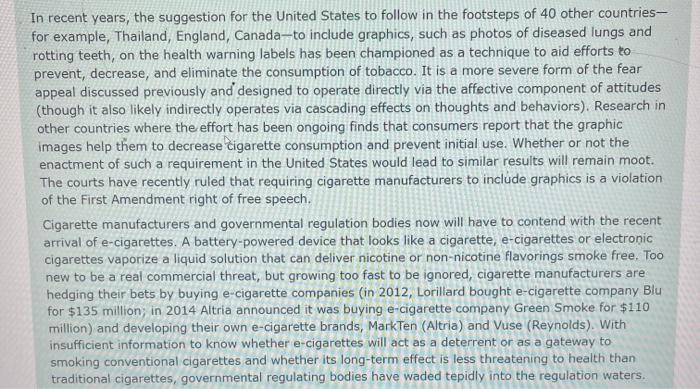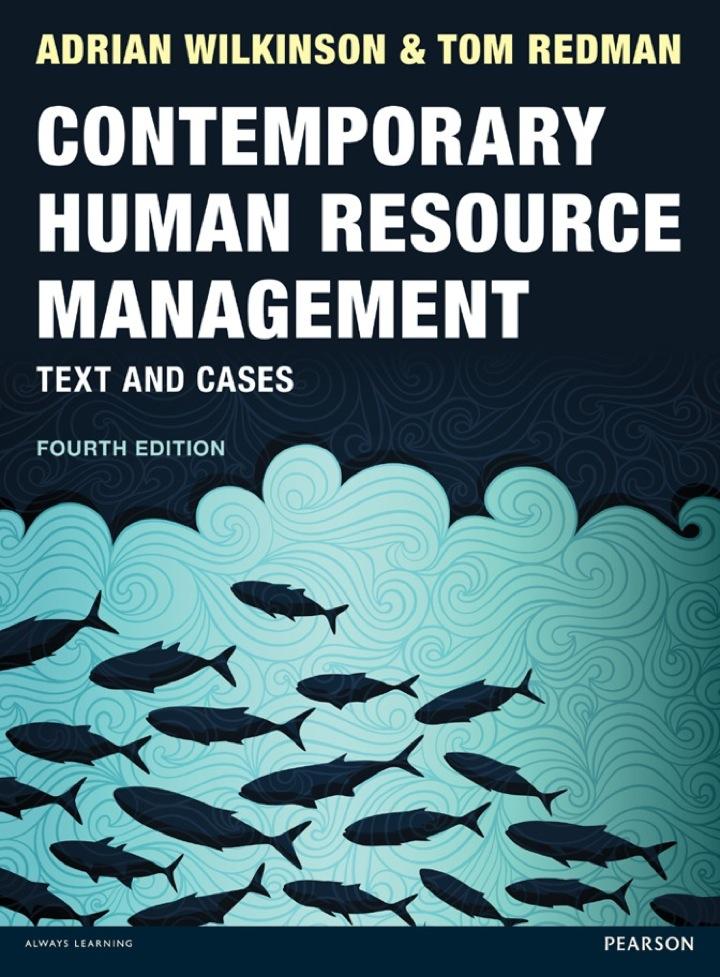Answered step by step
Verified Expert Solution
Question
1 Approved Answer
Prior to the 1970s, cigarette smoking was a perceived and promoted healthy habit recommended by doctors, Santa Claus, and infants. 76 Cigarettes were packed



Prior to the 1970s, cigarette smoking was a "perceived and promoted" healthy habit recommended by doctors, Santa Claus, and infants. 76 Cigarettes were packed with the c-rations provided to soldiers during WWII. Celebrities, including lovable cartoon characters Fred Flintstone and Barney Rubble of the long-running TV series The Flintstones, promoted the enjoyment of smoking cigarettes. Today smoking cigarettes is understood to be an unhealthy habit. The three pronged effort-affective, behavioral, cognitive-to decimate cigarette consumption, along with antismoking advertisements and the increase in cigarette prices, has been credited with the decline of smoking in the United States. To decrease consumer top-of-the-mind awareness (cognitive component), cigarette advertising was banned from TV and radio (1971). To make it harder to engage in smoking behavior, 38 states have some form of ban on smoking in enclosed public areas-restaurants, offices, theaters (behavioral component). To induce fear as a deterrent (affective component), cigarette packages were required to carry warning labels proclaiming its health hazard (1984). In recent years, the suggestion for the United States to follow in the footsteps of 40 other countries- for example, Thailand, England, Canada-to include graphics, such as photos of diseased lungs and rotting teeth, on the health warning labels has been championed as a technique to aid efforts to prevent, decrease, and eliminate the consumption of tobacco. It is a more severe form of the fear appeal discussed previously and designed to operate directly via the affective component of attitudes (though it also likely indirectly operates via cascading effects on thoughts and behaviors). Research in other countries where the effort has been ongoing finds that consumers report that the graphic images help them to decrease cigarette consumption and prevent initial use. Whether or not the enactment of such a requirement in the United States would lead to similar results will remain moot. The courts have recently ruled that requiring cigarette manufacturers to include graphics is a violation of the First Amendment right of free speech. Cigarette manufacturers and governmental regulation bodies now will have to contend with the recent arrival of e-cigarettes. A battery-powered device that looks like a cigarette, e-cigarettes or electronic cigarettes vaporize a liquid solution that can deliver nicotine or non-nicotine flavorings smoke free. Too new to be a real commercial threat, but growing too fast to be ignored, cigarette manufacturers are hedging their bets by buying e-cigarette companies (in 2012, Lorillard bought e-cigarette company Blu for $135 million; in 2014 Altria announced it was buying e-cigarette company Green Smoke for $110 million) and developing their own e-cigarette brands, MarkTen (Altria) and Vuse (Reynolds). With insufficient information to know whether e-cigarettes will act as a deterrent or as a gateway to smoking conventional cigarettes and whether its long-term effect is less threatening to health than traditional cigarettes, governmental regulating bodies have waded tepidly into the regulation waters. E-cigarettes are an interesting case study in attitude formation for new products. Companies are marketing the products as safe (cognitive component) and the users as sophisticated and individualistic (affective component), which will likely drive adoption in the future by consumers. Government regulating bodies are finding it hard to form "attitudes" towards this new nicotine delivery device due to the lack of information and research with which to form those attitudes. As we can see, attitudes are important for consumers, marketers, and government regulators. Critical Thinking Questions 1. Describe each attitude component used in deterring cigarette smoking in the U.S. 2. Using what you know about fear appeals, do you think the graphic approach will work better than verbal warnings? 3. Find and evaluate an advertisement for e-cigarettes using the information from this chapter.
Step by Step Solution
There are 3 Steps involved in it
Step: 1

Get Instant Access to Expert-Tailored Solutions
See step-by-step solutions with expert insights and AI powered tools for academic success
Step: 2

Step: 3

Ace Your Homework with AI
Get the answers you need in no time with our AI-driven, step-by-step assistance
Get Started


